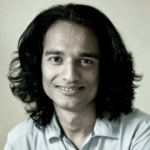
Yusuf Meherally
Freedom fighter and Socialist leader Yusuf Meherally was an excellent satirist and sloganeer known to coin slogans like “Simon! Go Back” and “British! Quit India” which made him a popular figure in India during the colonial period like Lord Byron. His best friend Minoo Masani described Yusuf as a warm, gentle, dedicated person. “With him, patriotism became a religion and nationalism a creed,” Masani said.
Yusuf wrote Leaders of India in two volumes and then went on to write the political satire A Trip to Pakistan which appeared in 1943 to be sold for a sum of four and a half rupees and became one of the most discussed books due to its elegant style and captivating sarcastic tone.
The book will remain one of the top political satires in modern Indian writings. It enriched the political writings of the pre-independence era. Its title itself was a satire, unlike The Train to Pakistan by Khushawant Singh which was published 13 years later. Pakistan was there even before the partition that replaced a part of it in the west to the far east, which has been known as Bangladesh since 1971. He had gone to visit Lahore and Punjab police served him the notice impossible to comply with legally, but still bearing the legend of the chief secretary. The “Governor of Pakistan” asked him to leave its boundaries within the next 12 hours. Since the next available train was not leaving Punjab within the stipulated time the experts advised him to continue with the visit. Finally, he landed up in Lahore Central Jail, where Bhagat Singh along with Shivram Rajguru and Sukhdev Thapar were hanged on 23rd March 1931. Precisely there he wrote such a masterpiece. On his return, the Congress Socialist Party nominated him to the post of Mayor of the city. He removed the slackness in the functioning of the municipality by personally attending to public grievances before starting the People’s Volunteer Brigade to cope with the Air Raid Precautions (ARP).
Yusuf Meherally was born on September 23, 1903, in Mumbai, and spent the first nine years in Kolkata, listening to Vande Mataram when Bengal was on the verge of partition. His father Jaffer Meherally Merchant was a prosperous businessman, whose grandfather was known to have started one of the first textile mills in the 19th century. He studied economics, history and law, before the enrollment at the bar in Mumbai, but due to the anti-Simon protest, and prosecution against the sergeant for the manhandling, he was not permitted to practice by the order of the Bombay High Court. Vinayak Damodar Savarkar was yet another qualified lawyer denied a license to practice for certain political reasons.
The Byron moment of his life and Lala Lajpat Rai had a connection of its kind. Lala died 18 days after the “Simon! Go Back” demonstration on October 30, 1928, at the protest march against the British Commission in Lahore. That baton within 19 years proved the nail in the British coffin, whether last or not can be debated further. A number of the Congress leaders including Jawahar Lal Nehru sustained injuries during this series of protests.
John Simon-led Commission arrived in India with the plenipotentiary powers, without having any Indian among its seven members. Parliamentarian Clement Attlee, who later became the prime minister of Britain (1945 – 51) was also a member of the Statutory Commission meant for the study of Constitutional reforms in British India. When they landed at the harbour, the 400 students of Bombay Youth League along with its founder and leader Yusuf Meherally launched a protest waving the black flags and the same slogan. They were beaten up badly in the 3 shifts. Saad Ali, his fellow prisoner during the Quit India movement in the Yerawada Central Jail, wrote that Yusuf too was beaten up badly.
Yatimkhana (orphanage) was a venue among numerous places that Yusuf had visited in Pakistan. It was a code word for the headquarters of the Servants of the People Society (SOPS). Explaining the code, he wrote, “Lala Lajpat Rai was the founder and the mainstay of the institution and since his death, it has been orphaned. Perhaps that’s why it is so called.” Yusuf soon reached there and exchanged views with its president Purushottam Das Tandon.
The details from Yatimkhana were hovering over my mind during my first visit this year to the headquarters of the Servants of the People Society at Lajpat Bhawan in New Delhi. It was the condolence meeting of its oldest life member Satya Paul, co-founder and president of the SAF (South Asian Fraternity) that nourished this spirit of Yusuf with the help of prime ministers like I.K. Gujaral, Atal Bihari Vajpayee and Dr. Man Mohan Singh and certain journalists like Kuldip Nayar since the early nineties.
Yusuf interacted with the inmates of Yatimkhana who used to be the dark horses of the independence movement. Most of them are largely either forgotten or neglected today, and it is here that Yusuf Meherally can be helpful. He described Lala Achintya Ram, the former president of SOPS and father of the former Vice President of India, as the sober face of an intellectual. Yusuf found Lala Jagannath to be affable, and Mohan Lal to be “so busy in touching the untouchables that he had hardly any time for the less civilised pursuits”.
Yusuf used certain adjectives like scholarly and sociable for the principal of the Tilak School of Politics, Chhabil Das and defined him further as a lion in the lecture hall, but rather hen-packed at home. The highly spoken of journalist Feroz Chand was reputed to be the most famous lotus-eater in “Pakistan” that Yusuf visited. They had exchanged views in Dr. Gopichand’s study before looking into the Lajpat Rai Hall and Dwarka Das Library.
Meherally opposed the partition of India, and was an ardent supporter of social harmony. He was afraid of a tremendous mass exodus, and wrote, “Perhaps some future Tolstoy would commemorate them in shining prose or burning verse for future generation to read.”
The moribund socialist movement in this age of hydra-headed socialist parties has been eagerly waiting for the likes of Yusuf Meherally, who had founded the Congress Socialist Party with Jayaprakash Narayan, Ram Manohar Lohia, Acharya Narendra Deo, Ramnandan, Achyut Patwardhan, Madhu Limaye, Minoo Masani and other members of the 42 Augusters’ Club.
Yusuf, as the Mayor of Bombay, was offered the best medical facilities of St. George Hospital when he suffered a debilitating heart attack in the Yerawada Central Jail. But he declined them since that was not available to the two other ailing freedom fighters. The British government released him on medical grounds after 14 months in 1943. He was lying unconscious in the general ward of the JJ Hospital for many days, then his admirers along with Gumastha Mandal contributed to sending him to the United States for treatment. In 1947, he had left for there, and returned in November next year, considerably improved.
On July 2, 1950, before his 47th birthday, Meherally left the mortals. The next day, the city that never stopped stood still for a few minutes as the clock struck midday. The Bombay Stock Exchange, though officially opened, witnessed no trading. The educational institutions, factories, mills, buses and trains were impacted. Mumbai celebrated his life and works in the collective mourning – an outcome of the affection, admiration, care and love for one of their own. At 4 pm, his coffin draped in the Tricolor started the 4-mile last journey from the Congress House to Dongri Kabrastan with dignified silence and respect.
Yusuf Meherally Centre is a tribute to Yusuf’s taller-than-canvas-size life. Centenarian Dr GG Parikh has led it since the sixties.
*Kaushal Kishore is the author of The Holy Ganga, Rupa 2008. The views published here are personal.






